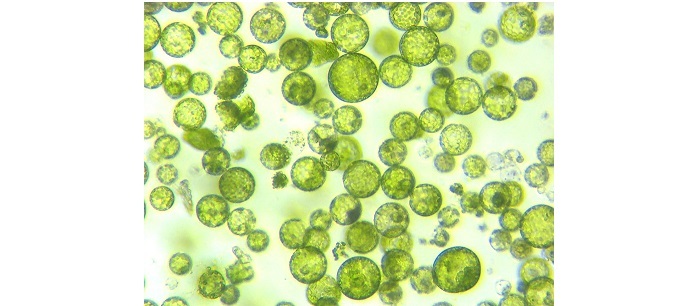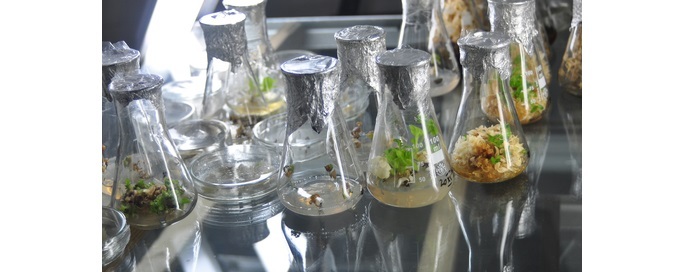
 Data Structure
Data Structure Networking
Networking RDBMS
RDBMS Operating System
Operating System Java
Java MS Excel
MS Excel iOS
iOS HTML
HTML CSS
CSS Android
Android Python
Python C Programming
C Programming C++
C++ C#
C# MongoDB
MongoDB MySQL
MySQL Javascript
Javascript PHP
PHP
- Selected Reading
- UPSC IAS Exams Notes
- Developer's Best Practices
- Questions and Answers
- Effective Resume Writing
- HR Interview Questions
- Computer Glossary
- Who is Who
Protoplast Fusion: Methods and Mechanism
Introduction
Protoplast fusion is a technique used in genetic engineering, plant breeding, and plant biotechnology. It involves the fusion of two plant protoplasts, or cells that have had their cell walls removed, to create a hybrid plant. Protoplast fusion has been used to create new plant varieties with desirable traits, such as disease resistance, improved yields, and increased nutritional value. Let's discuss the methods and mechanisms of protoplast fusion.

Protoplast
Methods of Protoplast Fusion
There are several methods of protoplast fusion, each with its own advantages and disadvantages. The most common methods are electrofusion, chemical fusion, and viral fusion.
Electrofusion
Electrofusion involves using an electrical current to fuse two protoplasts together. The protoplasts are placed in a solution containing a low concentration of ions, such as calcium or magnesium, and then subjected to an electrical current. The current causes the protoplast membranes to become permeable, allowing them to fuse together.
Electrofusion has several advantages over other methods of protoplast fusion. It is a quick and efficient method, with a high success rate. It is also a relatively simple process that does not require any expensive equipment.
However, there are also some disadvantages to electrofusion. The electrical current can damage the protoplasts, reducing their viability. The process can also generate heat, which can further damage the protoplasts. Finally, electrofusion can be difficult to control, and it may be difficult to achieve a high degree of specificity in the fusion process.
Chemical Fusion
Chemical fusion involves using a chemical agent to fuse two protoplasts together. The most common chemical agent used is polyethylene glycol (PEG). PEG is a water-soluble polymer that can form hydrogen bonds with cell membranes. When PEG is added to a solution containing protoplasts, it causes the protoplast membranes to fuse together.
Chemical fusion has several advantages over electrofusion. It is a gentler method that does not damage the protoplasts. It is also a highly controllable process, allowing for a high degree of specificity in the fusion process.
However, there are also some disadvantages to chemical fusion. The process can be time-consuming, taking several hours to complete. It also requires careful optimization of the PEG concentration and incubation time, as well as the pH and temperature of the solution. Finally, chemical fusion has a lower success rate than electrofusion, making it a less efficient method.
Viral Fusion
Viral fusion involves using a virus to fuse two protoplasts together. The virus is genetically engineered to express a protein that binds to the surface of the protoplasts, allowing them to fuse together.
Viral fusion has several advantages over other methods of protoplast fusion. It is a highly specific method that allows for precise control over the fusion process. It is also a gentler method that does not damage the protoplasts.
However, there are also some disadvantages to viral fusion. The process can be time-consuming, as it requires the genetic engineering of the virus. It also requires careful optimization of the virus concentration and incubation time. Finally, viral fusion is a less efficient method, with a lower success rate than electrofusion or chemical fusion.
Mechanisms of Protoplast Fusion
Protoplast fusion involves several mechanisms that allow the protoplast membranes to fuse together. These mechanisms include membrane destabilization, membrane fusion, and cell wall regeneration.
Membrane Destabilization
Membrane destabilization involves disrupting the lipid bilayer of the protoplast membrane. This can be achieved through the use of an electrical current, a chemical agent such as PEG, or a viral protein that binds to the surface of the protoplasts.
Disrupting the lipid bilayer causes the protoplast membranes to become more permeable, allowing them to fuse together. This occurs because the lipids in the membrane are no longer arranged in a stable configuration, which allows for the fusion of the two membranes.
Membrane Fusion
Membrane fusion involves the merging of the two protoplast membranes into a single membrane. This occurs as a result of the destabilization of the lipid bilayer and the formation of new lipid bonds between the two membranes.
The process of membrane fusion is facilitated by a group of proteins called fusogens. These proteins are responsible for bringing the two membranes together and promoting their fusion. In some cases, the fusogens are naturally occurring proteins, while in others, they are introduced into the protoplasts through genetic engineering.
Cell Wall Regeneration
After the protoplast membranes have fused together, the resulting hybrid cell lacks a cell wall. To create a viable plant, a new cell wall must be regenerated. Cell wall regeneration can occur through two mechanisms: self-regeneration and regeneration through a support matrix.
Self-regeneration involves the synthesis of new cell wall material by the protoplasts themselves. This occurs as the protoplasts secrete new cell wall material and build up a new cell wall around the fused protoplasts.
Regeneration through a support matrix involves placing the fused protoplasts on a support matrix, such as an agar plate. The protoplasts then synthesize new cell wall material on the matrix, creating a new cell wall around the fused protoplasts.
Applications of Protoplast Fusion
Protoplast fusion has several applications in plant biotechnology and breeding. Some of the most significant applications include ?
Creation of New Plant Varieties
Protoplast fusion can be used to create new plant varieties by fusing the protoplasts of two different plant species. This creates a hybrid plant with desirable traits from both parent plants.
Genetic Engineering
Protoplast fusion can be used to introduce new genetic material into a plant. By fusing the protoplasts of a donor plant with those of a recipient plant, the genetic material of the donor plant can be introduced into the recipient plant.

Disease Resistance
Protoplast fusion can be used to create plants that are resistant to certain diseases. This can be achieved by fusing the protoplasts of a disease-resistant plant with those of a susceptible plant, creating a hybrid plant with the disease resistance of the donor plant.
Increased Yield
Protoplast fusion can be used to create plants with increased yield. This can be achieved by fusing the protoplasts of two plants with complementary traits, such as one plant with a high yield and another plant with a high tolerance to stress.
Nutritional Value
Protoplast fusion can be used to create plants with increased nutritional value. This can be achieved by fusing the protoplasts of two plants with complementary nutritional profiles, creating a hybrid plant with improved nutritional content.
Conclusion
Protoplast fusion is a valuable tool in plant biotechnology and breeding. It allows for the creation of new plant varieties with desirable traits, such as disease resistance, improved yields, and increased nutritional value.
There are several methods of protoplast fusion, including electrofusion, chemical fusion, and viral fusion, each with its own advantages and disadvantages. The mechanisms of protoplast fusion involve membrane destabilization, membrane fusion, and cell wall regeneration.
By understanding the methods and mechanisms of protoplast fusion, researchers can continue to develop new and innovative plant varieties with improved traits.

